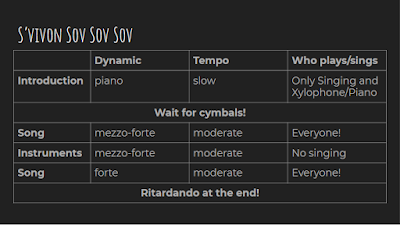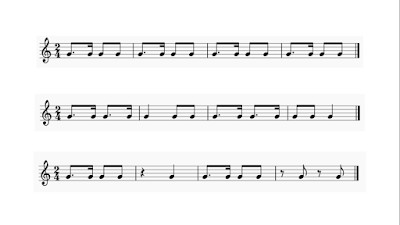At the beginning of the semester, Mrs. Hamilton and I had talked about using some kind of instruments in the final project, but hadn't yet been able to use them in any lesson. Mrs. Hamilton was happy to let me use instruments with her class, but she specifically picked this particularly well-behaved class to have that privilege; she was afraid that instruments in any other class (and perhaps even the one she had chosen) would cause students to become unmanageable. That was the challenge of this final project: could the students put together a song to play and sing for their peers without losing control of the class?
I think many music teachers have this fear--students can already be noisy on their own, before you add instruments. However, I think that class management can apply just as easily to instrument noise as student noise. Before any instruments would brought out, I showed this slide and made sure every student read it:
By introducing these expectations, we did not have any problems in this class throughout the preparation and performance of this final project. (At least, that I noticed. I have a high tolerance for noise sometimes.) Perhaps in another class, there would have be need to enforce these rules. However, as long as the expectations are set and rules are enforced by the teacher, I believe that instruments can be used without causing any more trouble for teachers. (More on the implications of this in a later post.)
Additionally, instead of integrating US History, we decided to teach about a holiday from another culture. Mrs. Hamilton's students are predominantly members of the Church of Jesus Christ of Latter-day Saints, so they are very familiar with Christmas traditions. However, not many of them know much about other cultural holiday traditions and celebrations. So I found a fun lyric video to help the students learn more about Hanukkah:
This is a song called, "S'vivon Sov Sov Sov," which translates to "Driedel, Spin, Spin, Spin."
I envisioned this lesson as having three objectives:
- Students will sing and play correct notes and rhythms for “S’vivon Sov Sov Sov” so that it is ready to perform.
- Students will be able to explain to other students why Hanukkah is celebrated and how “S’vivon Sov Sov Sov” explains some of the Hanukkah traditions.
- Students will apply different dynamics and tempos to “S’vivon Sov Sov Sov”
(see link to my lesson plan and slides at the end for more details)
Reflections
This was a decent plan, but as Mrs. Hamilton said after my lesson was finished, it would've been better to teach the students over a week.
In reality, we spent the majority of the lesson learning the song and the preparatory steps to getting instruments out. The biggest mistake in my planning was not realizing the amount of time this would take. I also underestimated the difficulty of some of the preparatory steps to instruments. For instance:
- I had students learn the "bass line," which would be played on a xylophone, by singing note names and "playing" the notes with their hands, as if they had an invisible keyboard in front of them. Remembering these letters and patterns proved much more difficult for students than I thought. If I could do it again, I would use words that started with same letter as the note they were playing (singing dog-ant-dog-ant-dog-ant-dog-ant to learn D-A-D-A-D-A-D-A) and display some sort of visual keyboard on a slide so the students could get some context to what they were learning.
- I assumed that the students wouldn't have a hard time clapping on the offbeat, so I figured that wouldn't take much time. However, the students couldn't clap the offbeat together by the end of class. If I did teach this lesson over a week, I would've taken time to have student practice this skill more.
I was glad that we had ended on an exciting note for the students. I also made sure to tell them how well they had done with some hard material. However, I had a lot to modify and reconfigure before our final lesson and performance for their peers to make sure this final culminating project went over well.
**********************************************************************************************




